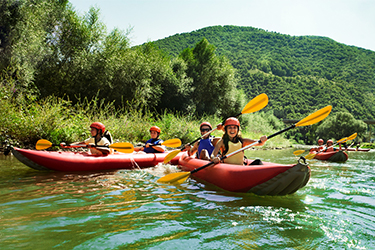
Summertime Fun with Paddle Sports
- Posted on:
- Posted in: Health
Tips for staying safe and sound while navigating the waterways in your canoe, kayak or paddle board.
Whether your preferred muscle-driven, on-the-water leisure transportation is by canoe, kayak or paddle board, like any other sport there are some safety precautions to heed in order to keep you – and your passengers’ – safe from harm on the state’s water highways.
Safety – first and foremost
- Everyone, especially children, should wear a personal floatation device (PFD) or life jacket in, on or around water – Good swimmer or not, Washington State law provides no person is allowed to operate a boat without a serviceable life jacket on board for each person on the vessel. Young children are required to wear life jackets. NOTE: Helmets are also highly recommended if you are running white water rapids in a kayak.
- The US Coast Guard and Canoe & Kayak magazine also recommend:
– Keep a whistle attached to your life jacket to communicate with other paddlers on the water and wear bright and noticeable clothing to be visible to other boaters.
– Understand water conditions including tides and currents.
– Before setting out be aware of air and water temperatures and wear the proper clothing for protection. Water as warm as 50-60 degrees Fahrenheit can initiate cold water shock and could be potentially fatal.
– Understand the rules of the waterways “roads.”
– In case of an emergency keep contact information on your equipment and let family or a friend know where you’re headed on your outing and when you plan to return.
– Be schooled on how your equipment works. Check your vessel and related equipment for any potential problems prior to heading out on the water and be sure you know the essential safety items that should be included. Also, be aware of what your vessel is designed to safely manage. For instance, different types of kayaks are built for different types of water use, such as lakes and rivers, the ocean and white water.
Get in shape before setting out and prevent paddling injuries
- Sea paddling is a sport – Are you strong enough to paddle for long periods of time and over long distances? Prepare your muscles and joints for an outing on the water and build up cardiac strength at the same time. Perform stretching exercises prior to your rowing excursions.
- Common paddling injuries are due to overuse affecting the wrist and forearm, rib cage, knee and lumbar spine. Help prevent injuries with exercise concentrating on core and upper back strengthening. Many of the strains from over-rowing can be calmed by anti-inflammatories, stretching, icing and rest.
For more information about paddling, visit:
– U.S. Coast Guard, http://www.uscgboating.org
– Canoe & Kayak Magazine, https://www.canoekayak.com/skills/paddling-safely/
– Stop Sports Injuries, https://www.stopsportsinjuries.org/STOP/Prevent_Injuries/Rowing_Injury_Prevention.aspx
By Holly Harmon for Puget Sound Orthopaedics
SHARE


